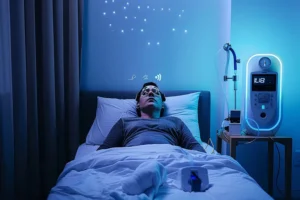Central Sleep Apnea (CSA) is a disorder where your breathing repeatedly stops and starts during sleep due to the brain’s failure to signal the muscles to breathe. Unlike obstructive sleep apnea, which occurs due to a physical blockage, CSA stems from communication issues between the brain and the respiratory system. This condition can lead to frequent awakenings and a reduction in the quality of sleep, ultimately impacting overall health. Potential treatments vary based on the underlying cause and may include the use of adaptive servo-ventilation devices, CPAP machines, or medication. Identifying and addressing risk factors such as heart disorders and opioid use can also be crucial in managing CSA.
Causes of Central Sleep Apnea
Central Sleep Apnea (CSA) is a condition characterized by the cessation of breathing during sleep due to absent respiratory effort. Unlike obstructive sleep apnea, where the airway is physically blocked, CSA involves a dysfunction in the respiratory control centers within the brain. Understanding the causes of CSA is crucial for effective diagnosis and treatment. The primary causes can be categorized into neurological factors, heart conditions, and medications.
It’s important to note that CSA can frequently manifest as a complex interplay of these factors. Identifying the exact cause can require comprehensive medical evaluation and diagnostic testing. Here, we delve into the specific contributions of neurological factors, heart conditions, and medications to the development of CSA.
Neurological Factors
One of the significant causes of CSA is related to neurological factors. The brain’s ability to send signals to the muscles that control breathing can be compromised, leading to irregular breathing patterns during sleep. Conditions such as brainstem lesions, neurodegenerative diseases (like Parkinson’s disease), and stroke can directly affect these control centers.
Additionally, certain genetic conditions can predispose individuals to CSA. For example, congenital central hypoventilation syndrome (CCHS) is a rare disorder where the autonomic control of breathing is impaired. In such cases, patients often require mechanical ventilation support during sleep to maintain adequate ventilation.
The complex interplay between the central nervous system and respiratory function means that any disruption in these neural pathways can potentially lead to CSA. Advanced imaging techniques and neurological assessments are often necessary to pinpoint these disruptions.
Heart Conditions
Heart conditions, particularly those affecting the heart’s ability to pump blood effectively, can also cause CSA. Congestive heart failure (CHF) is a prime example. In CHF, the heart’s reduced efficiency in pumping blood leads to a buildup of fluid in the lungs, which can trigger CSA episodes.
The mechanism involves changes in the body’s carbon dioxide levels. When the levels fluctuate, the body’s response to these changes can become erratic, leading to periods of apnea. This phenomenon is known as Cheyne-Stokes respiration, characterized by a pattern of progressive breath slowing and temporary apnea.
Moreover, studies have shown that CSA is prevalent in patients with atrial fibrillation, a common cardiac arrhythmia. The association is likely due to the shared risk factors and pathophysiological mechanisms that drive both conditions, including autonomic nervous system imbalance and structural heart abnormalities.
- Congestive heart failure (CHF)
- Cheyne-Stokes respiration
- Atrial fibrillation
Medications
Certain medications can also induce CSA by depressing the central nervous system. Opioids, commonly prescribed for pain management, are well-documented examples. They can alter the body’s respiratory control centers, resulting in reduced respiratory drive and subsequent apneic episodes during sleep.
Another group of medications that can lead to CSA are sedatives and certain types of sleep aids. These drugs work by enhancing the inhibitory effects of neurotransmitters in the brain, which can inadvertently suppress respiratory function. This suppression is particularly concerning in individuals who already have underlying respiratory or neurological conditions.
It’s critical for healthcare providers to assess the medication history of patients presenting with symptoms of CSA. Adjustments or alternatives in medication can often mitigate the apnea episodes. For instance, non-opioid pain management strategies might be considered to reduce the risk of medication-induced CSA.
The interplay between medications and sleep disorders underscores the need for a comprehensive approach when diagnosing and managing CSA. By understanding and addressing these contributing factors, better therapeutic outcomes can be achieved.
Understanding the myriad causes of Central Sleep Apnea can equip both patients and healthcare providers with the information necessary for effective management. To dive deeper into related topics, explore our other articles on sleep disorders and their treatments.
Symptoms of Central Sleep Apnea
Central sleep apnea (CSA) is a sleep-related disorder characterized by pauses in breathing due to a lack of respiratory effort during sleep. Unlike obstructive sleep apnea, where an obstruction in the airway causes breathing interruptions, CSA is caused by a failure of the brain’s respiratory control centers. Understanding the symptoms of CSA can help in early diagnosis and effective treatment.
One of the most noticeable symptoms of CSA is interrupted breathing during sleep, which can lead to various nighttime disturbances. Additionally, people with CSA often experience daytime fatigue and other related issues that significantly impact their quality of life.
Interrupted Breathing during Sleep
One of the hallmark symptoms of central sleep apnea is interrupted breathing during sleep. This occurs when the brain fails to send the proper signals to the muscles responsible for breathing, resulting in periods where breathing stops entirely. These interruptions can last from a few seconds to over a minute and may occur several times throughout the night. Individuals with CSA may not always be aware of these pauses in breathing, but partners or family members often notice the irregular breathing patterns. These interruptions can lead to sudden awakenings accompanied by shortness of breath or a feeling of choking.
In severe cases, the frequent oxygen desaturation and arousals can lead to chronic sleep disturbances, which may further exacerbate other health conditions. It’s essential to monitor these symptoms closely and seek medical advice if they are observed regularly.
Daytime Fatigue
Another significant symptom of central sleep apnea is daytime fatigue. Due to the constant interruptions in breathing and the resultant fragmented sleep, individuals with CSA often find it challenging to stay awake and alert during the day. This lack of restful sleep at night leads to excessive daytime sleepiness, which can impact daily activities and overall well-being.
People with CSA may experience difficulty concentrating and may find it hard to perform routine tasks effectively. This can lead to a decline in productivity at work or school and can also increase the risk of accidents, especially while driving.
In addition to excessive daytime sleepiness, other symptoms like morning headaches and mood changes such as irritability or depression can also occur. These symptoms collectively highlight the importance of addressing and treating CSA to improve both nighttime and daytime quality of life.
If you suspect you or a loved one may be experiencing symptoms of central sleep apnea, it’s crucial to consult with a healthcare professional for accurate diagnosis and appropriate treatment. Early intervention can help mitigate the adverse effects of this sleep disorder. For more insights into sleep-related issues and their treatments, consider reading our other articles.
Treatments for Central Sleep Apnea
Central Sleep Apnea (CSA) is a condition characterized by repeated episodes of stopped breathing during sleep due to a lack of respiratory effort. Unlike obstructive sleep apnea, CSA is related to the central nervous system rather than the airway. Effective management of CSA often involves a multifaceted approach that includes various treatment options such as Positive Airway Pressure (PAP) Therapy and medications.
Given the complexities involved in CSA, it is crucial to consult with healthcare providers to determine the most suitable treatment plan. Each patient may respond differently to treatments, making personalized care essential for optimal outcomes.
Positive Airway Pressure (PAP) Therapy
Positive Airway Pressure (PAP) therapy is a common and effective treatment for Central Sleep Apnea. PAP therapy works by providing a continuous stream of air through a mask to keep the airways open and maintain respiratory effort during sleep. This type of therapy has been widely researched and is supported by numerous clinical trials for its efficacy in treating CSA.
There are several types of PAP devices, including Continuous Positive Airway Pressure (CPAP), Bi-level Positive Airway Pressure (BiPAP), and Adaptive Servo-Ventilation (ASV). Each type offers unique benefits:
- CPAP: Delivers a continuous, steady air pressure.
- BiPAP: Provides different pressures for inhalation and exhalation.
- ASV: Adapts to the patient’s breathing patterns in real-time.
Research indicates that ASV may be particularly effective for patients with CSA, as it adjusts the air pressure based on the detected breathing effort, thereby reducing apneas and improving the quality of sleep.
Medications
Medications can also play a significant role in the treatment of Central Sleep Apnea. While PAP therapy is often the first line of treatment, medications can be beneficial in managing symptoms, particularly for patients who do not respond well to PAP therapy or have underlying medical conditions contributing to CSA.
Two commonly used medications include:
- Acetazolamide: This drug helps stimulate breathing by inducing a mild metabolic acidosis, which increases the drive to breathe.
- Theophylline: A bronchodilator that can improve respiratory function and reduce the frequency of apneas.
Clinical studies have shown that these medications can be effective in reducing the frequency and severity of central apneas, particularly in patients with coexisting heart failure or high-altitude periodic breathing. However, medication management should always be overseen by a healthcare provider to monitor potential side effects and interactions with other treatments. For more in-depth information on various treatment options, including lifestyle changes and surgical interventions, consider exploring other articles in our series on sleep apnea management.
Frequently Asked Questions About Central Sleep Apnea
If you’re looking for more information after reading our main article on Central Sleep Apnea, here are some of the most commonly asked questions and their answers.
What is the primary difference between central sleep apnea and obstructive sleep apnea?
Central sleep apnea (CSA) is primarily caused by a failure of the brain to send appropriate signals to the muscles that control breathing, leading to interruptions in breathing. In contrast, obstructive sleep apnea (OSA) occurs when there is a physical blockage in the airway, typically when the soft tissue in the back of the throat collapses during sleep. Despite their differences, both conditions result in disrupted sleep and insufficient nighttime breathing.

My name is Salman Kapa, a 73-year-old expert in bone regeneration and dental implantology. With decades of experience in the field, I am dedicated to advancing our understanding of oral health and hygiene. Through my research and writing, I aim to contribute to the development of innovative solutions in dental care.




